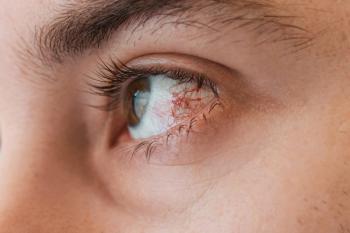
Optometry must adapt to evolving AI
Imagine a computer that creates patient care plans, a front office that holds no inventory, and patients who have their optometry visits in virtual reality.
Atlanta-Imagine a computer that creates patient care plans, a front office that holds no inventory, and patients who have their optometry visits in virtual reality.
This is one potential future scenario that may be in store for optometry, and it may be coming sooner than most practitioners realize, according to Howard Purcell, OD, FAAO, senior vice president of customer development of Essilor of America, Inc.
Speaking at SECO 2017, Dr. Purcell described a future that may sound like more like science fiction than fact, but he assured his audience that major, industry-disruptive technology is already in the works. Optometrists will be faced with making fundamental decisions about how their practices will function in the next three to10 years.
Related:
AI is coming
One of the biggest industry disruptors across sectors has been artificial intelligence (AI). Already present in numerous daily applications, such as Siri and Cortana on mobile phones, research into AI is developing at a break-neck pace.
Companies such as Google, Apple, Microsoft, and Facebook are all vying for the future of AI integration into people’s daily lives, and optometry is not immune to the changes.
“Artificial intelligence will change your professional lives in the next two to three years. And it already has changed it in many ways; you just don't call it artificial intelligence,” Dr. Purcell says.
Dr. Purcell predicts that AI will change optometry in the area of information storage and retrieval.
Related:
“What if everything you learned from the first day you went to optometry school to five minutes ago could be available at your fingertips?” Dr. Purcell says.
Such a tool would allow optometrists to enter a patient's history, symptoms, and other information and cross-reference it against the optometrist’s years of experience and learning-presumably enhancing patient outcomes.
IBM Watson Health, based on the famous predecessor that defeated some of the game show Jeopardy!’s best past contestants, is already computing for health care professionals in other fields.
From accelerating the rate at which genetic testing results are generated to creating personalized care plans, Watson is being used by medical professionals in ways never before possible.
As with any disruptive technology, AI has sparked fears of replacing humans in various industries, but optometrists should breathe easy, Dr. Purcell says.
“When our patients become robots, yes, AI will take over for us. Until that time, it’s a tool,” he says.
AI will be an invaluable tool that will help doctors make decisions rather than make the decisions on their behalf, he says.
Related:
3D printing options growing
Something closer to fundamentally changing the way optometrists practice is 3D printing-which is becoming more accessible with each year. It’s no longer the printer but the printing materials that represents the greatest cost,. As prices continue to come down, 3D printing usage continues to accelerate.
Used in medicine for several years now, 3D printing will soon allow for once unimaginable applications, such as printing organs that match the ones seen in a patient preparing for a surgery. In optometry, this may one day lead to advances in printing ocular cells and membranes.
But Rather than looking at concepts that border science fiction, Dr. Purcell suggests thinking about something so closer to reality it's is bound to show up in the next few years: 3D printing frames.
“If you want to 3D print an Oakley frame, in a specific color, in a specific style, for that particular patient, you'll be able to do that in your office,” Dr. Purcell says.
He suggests that soon offices will be able to pay a click fee each time they click a print button, and frame design specifications will be sent to the office 3D printer. This printer will create a new, custom frame within hours or even minutes.
Such a capability will be a paradigm shift, perhaps even leading to some opticians dropping the larger, expensive inventories in favor of a few key display pieces and a few top-of-the-line 3D printers.
Related:
Efforts toward 3D printing spectacle lenses are also underway, he says, although the technology is currently still in its infancy. Current iterations yield hazy, inaccurate printouts, but it’s only a matter of time before that, too, becomes good enough to be widely accepted.
“Do you remember the first cell phone that you owned?” says Dr. Purcell. “It probably looked a little different from the cell phone that you have today.”
It’s just a matter of time as techniques improve, practitioners of today will eventually see this technology within their lifetimes, he says.
Virtual reality: Snellen chart of the future
Virtual reality may end up being part of the solution to replacing the antiquated Snellen acuity chart.
“That norm was established in the mid-1800s. It's not good enough anymore,” Dr. Purcell says. “The eye exam is too easy. People are going to pass your eye exam who have visual needs because we’re using a standard that perhaps is outdated.”
Instead, new standards that aim to enhance vision, rather than simply normalize it, should be adapted. Virtual reality may offer some insights into how this could be done-while enhancing the patient experience.
“I’m going to suggest that over the next 10 years, the chair, stand, projector, and what else you use in your practice is gone," says Dr. Purcell.
He gave the example of a patient coming in to the office. and Rather reading a Snellen chart, the patient will instead be immersed in a familiar environment such as the tennis court, an office, driving, or anything else that helps the patient experience adjustments from lenses.
“Virtual reality is coming to our space, and you have to decide whether it’s the right thing for you,” Dr. Purcell says. “But I would ask you to think about the patient experience.”
The current care experience is not very exciting, he admits, but he suggests that the future experience will be exciting to patients and may drive increased engagement.
Related:
Optometry should jaywalk more
Adapting to the incoming changes will require a metaphorical cognitive adjustment for the industry as a whole, Dr. Purcell says. He likened the industry to people using crosswalks vs. jaywalkers.
A study found that jaywalkers were at lower risk of injury than crosswalk users because they tended to be more cautious and aware of the risks they were taking. On the other hand, crosswalk users ignored their surroundings and had a false sense of security.
“The profession of optometry needs to jaywalk more,” Dr. Purcell says. “They're so traditional that they've opened themselves up to disruptive things that are coming in a big way.”
Ultimately, changes are coming, regardless if the industry is prepared.
Practices that will endure these changes will most likely be those that embody three key traits:
• Clear mission and purpose that grounds and guides the practice through changing times
• Frontline obsession with ensuring every detail is addressed
• Ownership mentality not just among the practice's proprietor, but the whole staff
These traits are consistent factors in businesses that continue to succeed and grow over decades, and they will likely be of benefit through disruptive industry changes as well, says Dr. Purcell.
Newsletter
Want more insights like this? Subscribe to Optometry Times and get clinical pearls and practice tips delivered straight to your inbox.



















































.png)


